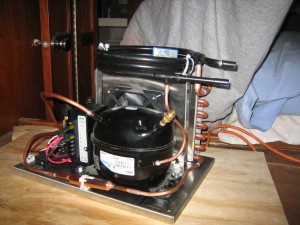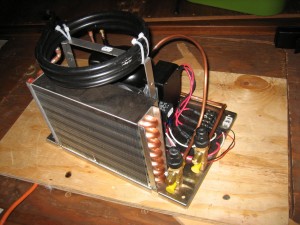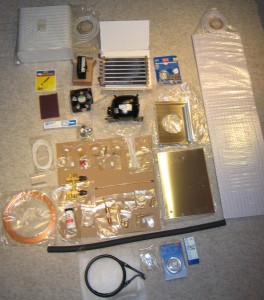Jun 16 2009
Refrigeration
I built this:


Out of this:

I read Nigel Calder’s “Refrigeration for Pleasureboats” three times, I read Richard Kollman’s forum on marine refrigeration, and I spoke with Marcus a few times (a fellow cruiser-friend in the marina). Marcus is lending me his top-quality, indispensable refrigeration tools (much thanks to Marcus!), and also turned me on to RParts, where I ordered all my stuff. I learned how to “sweat” copper tubing (i.e. silver soldering copper), how to form flare fittings, how to use a refrigeration gauge set, the detailed principles behind refrigeration, and I built my own refrigeration system. I’m pretty proud of this 1.5′ x 1.5′ x 1′ cube of refrigeration goodness–it’s hard to believe that a month ago I didn’t understand how this thing worked, and now I’ve built my own out of parts. It’s not making anything cold yet, but I pressure tested it yesterday and to my immense satisfaction and relief I have no leaks! (that’s huge–to find and fix a leak would have been a nightmare)
Refrigeration is a lot more interesting once you understand how it works. You don’t want to hear the details, but I have admin access on this blog so I’m going to tell you all about it.
—————————————————————————————————————————
A refrigerator works by moving heat from one place to another. It does not “create” cold. Heat is removed from the icebox and deposited at the “hotbox” (that’s my own term, it will be helpful for the discussion). On our boat, the hotbox happens to be the storage space under the quarterberth; for your fridge at home, the hotbox is just the space behind the fridge.
On each side of the circuit there is a heat exchanger. The heat exchanger transfers heat from the air to the refrigerant in the icebox, and from the refrigerant back to the air in the hotbox. The heat exchanger in the icebox is called the evaporator; the heat exchanger in the hotbox is called the condenser.
The refrigerant is the medium that moves the heat around the circuit. If the refrigerant was simply pushed around in a circle, it would not be inclined to transfer heat out of the cool icebox into the warm hotbox–that would be trying to push the heat uphill, so to speak. The key is to pressurize the refrigerant, using a compressor. When the refrigerant is compressed, it warms up; when it de-compresses (expands) it gets cold. The refrigerant comes out of the icebox medium-warm. The compressor pressurizes the refrigerant, which heats it up. Then the pressurized refrigerant passes through the condenser–which looks like a mini car radiator–and as the refrigerant passes through the condenser its heat is transferred to the air (just like your car radiator, in fact). The refrigerant returns to the icebox at a mediumish temperature, but this time it’s pressurized. At the icebox, the refrigerant is allowed to expand–which causes it to get cold. The cold refrigerant sucks up heat as it passes through the evaporator. Then the process is repeated. Good diagram.
There’s one more principle at work: phase changes. If you just pumped a liquid around in circles, from the evaporator to the condenser to the evaporator to the condenser, etc, then you might be able to remove a small amount of heat from the icebox and dump it at the condenser. However, you can’t suck up much heat just by warming up a liquid and then cooling it off. The real way to suck up heat and drop it off elsewhere is to use a PHASE CHANGE to your advantage. The phase change is the key to the whole process.
Consider heating a quart of water in a pot on the stove. It takes 320 BTU of energy to heat that water from 33 degrees F to 211 degrees–320 BTU to change the temperature of the water by 178 degrees. Then, to heat that water only 2 more degrees, from just 211 degrees to 213 degrees, it takes 1934 BTU! Because at 212 degrees, the H2O changes from water to steam; this is the phase change. During the entire process of converting water to steam, you keep dumping in large quantities of energy and the temperature stays the same–all the energy goes into the conversion from liquid to gas. The message is that the energy required to do a phase change from water to steam is WAY GREATER than the energy required to change the temperature of the water itself.
In refrigeration, we store our heat as a phase change of the refrigerant in order to efficiently transfer it from the icebox to the hotbox. We don’t use water though, because we want the phase change to take place around the 20 degrees F in our refrigerator (not very helpful to us for it to take place at 212 degrees). We use refrigerant specially formulated to undergo the phase change near freezing (in our case, R134a).
We pump a liquid to the evaporator, and then let it expand into a gas; that expansion to a gas sucks huge amounts of heat out of the box. Then back at the compressor we compress the gas, which heats it up (essentially exchanging “pressure energy” for heat). Then we send it through the condenser, where the the hot gas dumps off all its heat and turns back into a liquid (condenses!) in the process. Then we sent the liquid back to the evaporator, where it turns into a gas again . . . and so on. The refrigerant goes to the icebox as a liquid, but it returns as a gas; the phase changes that happens in the icebox and the hotbox are the primary means of temporarily storing the heat in the refrigerant for transfer from one location to another.
Refrigeration is by far the single largest energy sink on a cruising sailboat. In the average residential home, refrigeration is 5% of the energy bill–not an insignificant amount. One site says that the average fridge uses ~$8 of electricity per month, depending on how big, what kind, and where you live. The efficiency of the refrigeration system depends very strongly on the refrigerant dumping off heat as it passes through the condenser. Most systems use air-cooled condensers (I put in both air-cooled and water-cooled condensers–the air-cooled is the radiator-looking thing in the picture above; the water-cooled is the black circle of tubing on the top of the apparatus). If the air-cooled condenser is located in a cool spot with good air-flow, this heat dump can happen very effectively; if the condenser is located in a hot spot with stagnant air, or even worse in the hot engine room, then the refrigeration cycle’s efficiency plummets. Meaning that the fridge runs much longer, and consumes much more power. Moral: the quickest improvement you can make to reduce your energy needs on a sailboat is to improve the air circulation around the refrigeration condenser.
You can do the same for your fridge at home: just pull the fridge away from the wall an extra inch, and you’ll greatly increase the air-circulation around the condenser, improving the efficiency. Avoid shoving plastic or paper bags between the wall and the fridge for storage–that’s not helping out your fridge, or your electrical bill. Even better, use a vacuum to clean off the condenser tubing on the back of the fridge–that gunk kills the condenser’s ability to dump heat.
